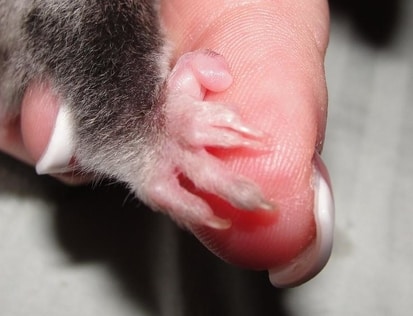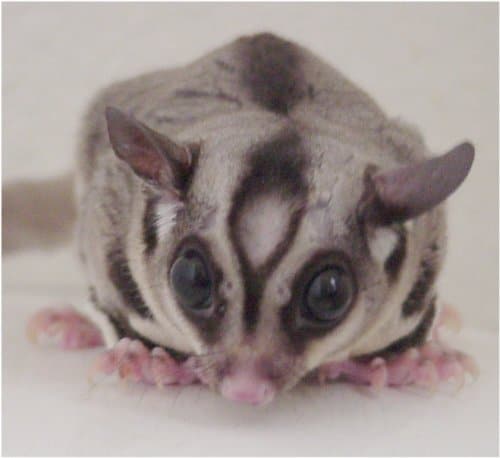Sugar gliders are amazing creatures that are often kept as pets. There’s much to discover about these adorable creatures so let’s dig straight into the top 30 sugar glider facts!
If you’re an avid sugar glider fan you might know some of these facts already, but even if you are, I’m sure there are some facts in this list that you don’t know!
[no_toc]30 Sugar glider facts
1) The “sugar” in their name comes from the fact that they love sweet foods
Sugar gliders absolutely love sweet food, which is why they’re named the way they are. Most of the foods they prefer to eat are sweet fruits and nectar.
2) The second part of their name comes from their gliding ability
There’s a common misconception that sugar gliders can fly. That’s not the case, they can not fly, but what they can do is glide through the air. They have a flap of skin between their arms, which when they spread their arms allows them to soar through the air for impressive distances. In the wild, they usually use this ability when jumping from trees.
3) They can glide for up to 165 feet!
165 feet is a pretty crazy distance to glide. It’s equivalent to the width of an entire football field. An impressive feat for such a tiny creature! Also, now you know where they get their name from!
4) Sugar gliders are marsupials
There’s a lot of confusion regarding this subject. A lot of people mistakenly believe that sugar gliders are monkeys but this is not the case. Sugar gliders are in fact part of the marsupial family. Marsupials carry their young in their pouch. Other marsupials you might be familiar with are kangaroos and koalas.
5) Sugar gliders have 4 hands
Something very interesting about sugar gliders is that they have four hands. Instead of hands on the front and feet on the back, they have hands on both sides!
6) They have opposable thumbs
On each of their 4 hands, they have opposable thumbs. They can use these thumbs to climb, groom, and hold food and toys. Opposable thumbs are characteristic of primates, which might be why so many people believe that sugar gliders are monkeys.
7) Gliders have four fingers on each hand
4 fingers on each hand with 4 hands means they have 16 fingers in total!
8) The second and third fingers of sugar gliders are fused

Sugar gliders have a natural “comb”. Their second and third fingers are fused. This gives them a natural comb that they use to groom themselves and other members of their colony. Sugar gliders love to groom, which is most likely why they evolved to have a natural comb.
9) Sugar gliders have big eyes which give them excellent night vision
Sugar gliders have large, spherical dark eyes that give them excellent vision in the dark. Additionally, since their large eyes protrude from their head they have a very good field of vision.
10) Wild Sugar gliders live in groups of up 7 individuals
A group of sugar gliders is called a colony. In the wild, they form colonies consisting of up to 7 adult gliders and their young. They are highly social animals.
11) The teeth of sugar gliders do not keep growing
Because of the way sugar glider’s teeth look some people confuse them with rodents. Rodents have teeth that keep growing, and while the teeth of sugar gliders look quite a bit like those of rodents, they are not in fact rodents. Their teeth do not grow perpetually and because of this, they do not need to gnaw on things to keep the size of their teeth in check.
12) Sugar gliders are omnivores
Sugar gliders are omnivores, meaning they eat both meat and plant-based foods. In the wild they eat insects in the summer, in the winter, when insects are more scarce, they feed mostly on fruits and saps.
13) Gliders come in many different colors
Sugar gliders can have many different colors and patterns. The most common color they come in is called “standard grey” but they can also be white, albino, mosaic, or caramel-colored.
14) Sugar gliders have a long lifespan
In the wild, they have a lifespan of 3 to 9 years while in captivity they can live up to 15 years! If you compare this to other animals their size it’s an incredibly long lifespan comparable to that of dogs and cats.
15) Sugar gliders are intelligent animals
Some people claim that the intelligence of this creature is similar to that of dogs. There are no studies done to confirm this, but personal experiences from glider owners tell us that they can learn and respond to the name you give them. They are also able to open latches.
16) Gliders are nocturnal critters
These creatures spend most of their days sleeping and are awake during the night.
17) Sugar gliders can bark
Sugar gliders can make various sounds such as crabbing, hissing, and barking. They usually bark to alert their colony or if they spot something (or someone) they’re not familiar with.
18) Male gliders have a bald spot

It’s true; male gliders have a bald spot on their head. The reason why they have this is that they have a scent gland there, which allows them to mark their territory.
19) Grooming is one of their favorite pastimes
These tiny marsupials are very clean creatures. They rarely smell and do not require baths when kept as pets. They groom themselves and other members of their colony very frequently to stay clean.
20) Some states have banned sugar gliders
There are several states where the ownership of a sugar glider is illegal. States such as California, Alaska, and Hawaii outright ban anyone from owning a sugar glider to “protect public health and safety, agriculture, wildlife, and natural resources.”
21) In the wild, sugar gliders spend most of their time in the trees
Wild sugar gliders spend most of their life living in the trees. That’s also why their gliding ability is so important; it allows them to glide from tree to tree and get away from potential predators.
22) Gliders are native to Australia, New Guinea, and Indonesia
Sugar gliders are endemic to the north and east coast of Australia, several islands in Indonesia, and New Guinea. For about 20 years now they’ve also been bred in captivity in other countries such as the United States to meet the high demand for these creatures in the pet trade.
23) Each colony has a territory of around 2.5 acres (1 hectare)
They might be small animals, but they defend quite a large territory. Every colony defends a territory that’s about 2.5 acres in size. They mark this territory with their scent glands to deter intruders from coming in.
24) Sugar gliders mark the members of their colony
Sugar gliders use their scent glands not only to mark their territory but also to mark who is in their tribe. Since they have powerful noses scent is a very powerful tool for them to recognize who belongs to their colony and who doesn’t.
Usually, the dominant males mark the rest of the colony. Intruders who lack the appropriate scent marks are violently expelled from their territory.
25) Sugar gliders huddle up to stay warm
During cold winter nights, sugar gliders tend to huddle up together to stay warm. This helps them preserve energy because they do not need to expend as much energy on heating their body if they share their warmth.
26) While gliding, they use their tail to steer
The tail of the sugar glider has many uses, one of the most important uses of their tail is that they use it as a way to steer when they’re gliding. That way they can change the direction they’re gliding towards. They use it in a way that’s similar to how a rudder works on a ship.
27) Sugar gliders have great hearing
Sugar gliders have thin, almost hairless, relatively large ears that can move independently from one another. This is useful because it allows them to very quickly identify and locate sounds coming from anywhere. It’s a good way to identify threats and respond to them as quickly as possible.
28) Their scientific name is Petaurus Breviceps
Petaurus Breviceps means short-headed rope-dancer in Latin. This scientific name is a reference to their tree-top acrobatics which they’re well known for.
29) Sugar gliders can form strong bonds with pet owners
Taking care of a pet sugar glider is no joke. They require a lot of attention and you need to spend a lot of time feeding and playing with them. However, the payoff is worth it. Sugar gliders can form strong bonds with their owners if you treat them well.
30) In captivity, sugar gliders require a very specific diet
Sugar gliders in nature eat a diet that’s hard to replicate in captivity. Foods such as the saps they consume in the wild are simply not very widely available in stores. Luckily, there are ways to feed pet sugar gliders that emulate their natural diet quite well.
Many owners of pet sugar gliders follow special recipes to give their glider all the nutrition it needs.
- How Long Do American Eskimo Dogs Live? Important Factors and Care Tips - September 29, 2023
- Do American Bulldogs Need Grooming? Essential Tips and Care Guidelines - September 29, 2023
- Do Bengal Cats Enjoy Playing? Essential Tips for Keeping Them Active - September 29, 2023